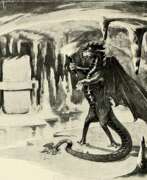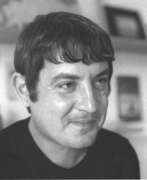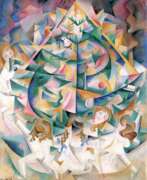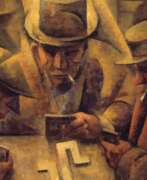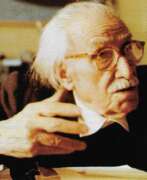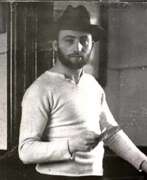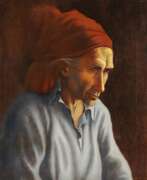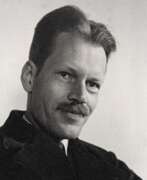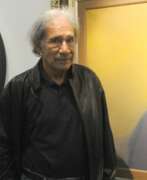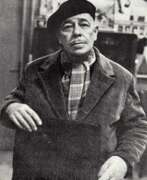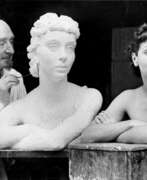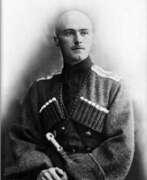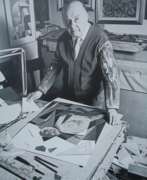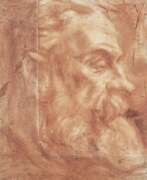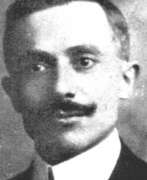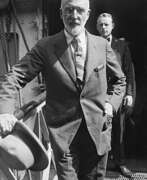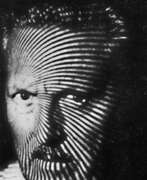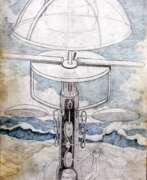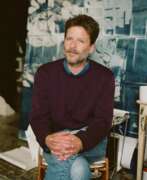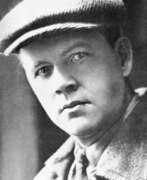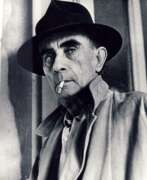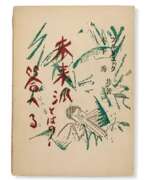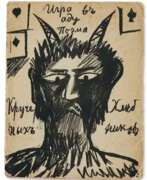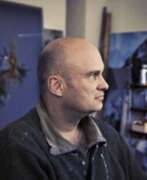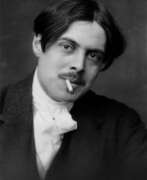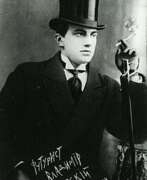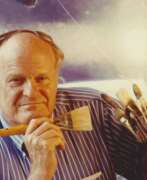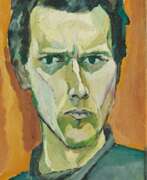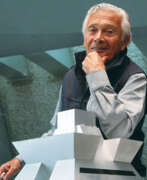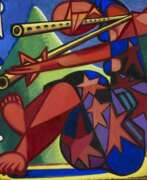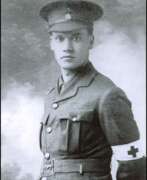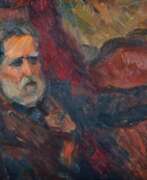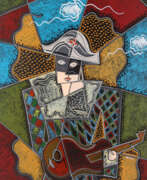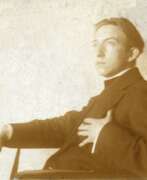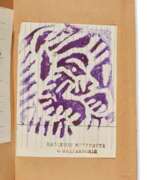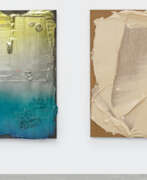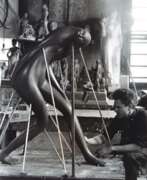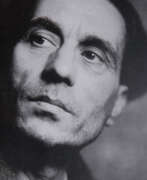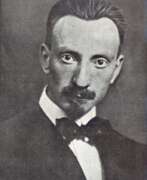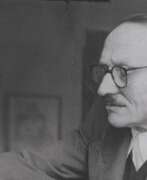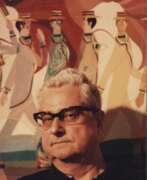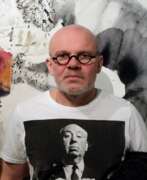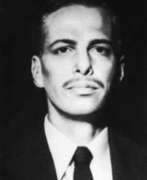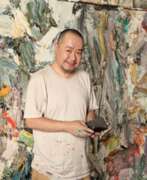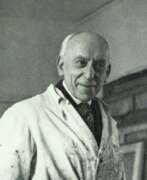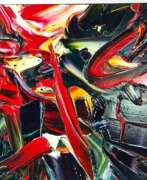Painters Futurism
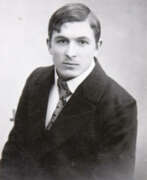

Wäinö Waldemar Aaltonen was a Finnish artist and sculptor, celebrated for his contributions to the cultural landscape of Finland, particularly during the early years of the nation's independence. Born in 1894, Aaltonen's works are distinguished by their nationalist themes and monumental scale, often reflecting the spirit and identity of Finland. His artistic journey was notably influenced by a trip to Italy in 1923, where he encountered cubist and futurist art, elements of which he integrated into his own work.
Aaltonen's sculptures are key features in Finland's public spaces, including the well-known statues in the House of Parliament and numerous works in Turku, such as the "Lily of Turku" and a statue of the runner Paavo Nurmi. His mastery is also showcased at the Wäinö Aaltonen Museum of Art in Turku, which houses a significant collection of his sculptures, paintings, and drawings. This museum not only celebrates his legacy but also serves as a central repository for his extensive works, donated by Aaltonen himself.
For those interested in exploring Aaltonen's work and the impact of Finnish sculpture, a visit to the Wäinö Aaltonen Museum of Art is invaluable. The museum provides a comprehensive view of his artistic evolution and contributions to Finnish art. For updates on exhibitions and events related to Wäinö Aaltonen, consider signing up for notifications through the museum's mailing list, ensuring you stay informed about new insights and offerings related to this pivotal artist.
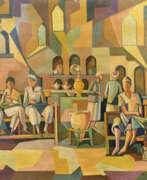

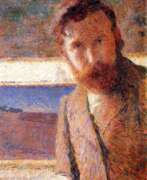

Giacomo Balla was a great painter of the 20th century, representative of the first wave of Italian futurism, one of the most influential masters of the last century.
Giacomo Balla's work is an attempt to convey dynamics, to capture the very essence of movement. His paintings are lyrical, full of light and rhythm.
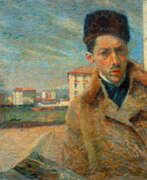

Umberto Boccioni was a famous Italian artist of the early 20th century, an avant-garde sculptor, the founder and inspirer of Futurism.
Umberto Boccioni made a great contribution to formation of philosophy and aesthetics of the movement. He was one of the creators of the Futurist Painting Manifesto and personally developed the Futurist Sculpture Manifesto.
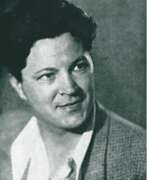

Fyodor Semyonovich Bogorodsky (Russian: Фёдор Семёнович Богородский) was a distinguished Russian painter, graphic artist, and theatrical designer, celebrated for his contributions to Soviet art. Born in Nizhny Novgorod and initially studying law at Moscow University, Bogorodsky's passion for art led him to VKhUTEMAS, where he honed his craft under notable figures such as A.E. Arkhipov. His unique journey included serving as a sailor and pilot during World War I, which profoundly influenced his art, often depicting sailors as his main subjects, a testament to his own experiences and admiration for their lifestyle.
Bogorodsky's artistry earned him the title of Honored Artist of the RSFSR in 1946, and his work "Glory to Fallen Heroes" received the prestigious Stalin Prize in 1945, later commemorated on a Soviet postage stamp in 1965. His commitment to depicting the valor and hardships of the Soviet people, especially sailors and the underprivileged, made him a significant figure in the realm of Soviet realism.
His works are preserved in esteemed collections, including the State Tretyakov Gallery and the State Russian Museum, showcasing his contributions to Soviet art and culture. Bogorodsky's legacy extends beyond his paintings, as he also made significant contributions to the fields of teaching, poetry, and theater.
For collectors and experts in art and antiques, Fyodor Bogorodsky remains a symbol of the intertwining of art, history, and personal experience. His dedication to capturing the essence of Soviet life, coupled with his remarkable technique, ensures his place in the annals of art history. Sign up for updates on new product sales and auction events related to Fyodor Semyonovich Bogorodsky to further explore the depth of his works and their impact on Soviet art.
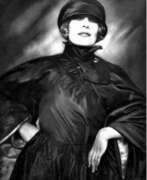

Kseniya Leonidovna Boguslavskaya (Russian: Ксения Леонидовна Богуславская) was a twentieth-century Russian artist who lived and worked in Germany and France for most of her career. She is known as a painter, graphic artist, theatrical artist and designer, and poetess.
Kseniya Boguslavskaya was a representative of the avant-garde school. She created semi-abstract cubo-futuristic compositions, including landscapes, still lifes, genre scenes, and images of interiors. In the same style, the artist drew sketches for articles of applied art. She also illustrated covers of publications and worked as a scenographer.
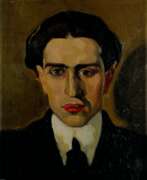

Aroldo Bonzagni is an Italian painter, draughtsman and illustrator. He studied at the Brera Academy in Milan.
Aroldo Bonzagni was friends with Umberto Boccioni and joined the Futurist group. His style was marked by expressionism and his drawings show a certain irony. He also does a number of erotic sketches, but privately intended for collectors.


Hans Brass was a German artist of the first half of the twentieth century. He is known as a painter and graphic artist, famous for his expressionist works.
Hans Brass created landscapes in a traditional style at the beginning of his career. However, between 1917 and 1923 he turned to Expressionism, Cubism and Futurism. From 1921 he became interested in abstract art, and until 1933 he created abstract works and works with religious content. By 1948 Brass had developed his own unique style based on his expressionist experience. From 1952 he worked in watercolor, depicting landscapes and flowers.
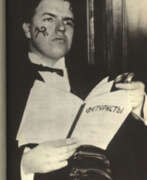

David Davidovich Burliuk (Russian: Давид Давидович Бурлюк), a pioneering figure of the Russian Futurist movement, was a Ukrainian poet, artist, and publicist, born in 1882 in Semirotovshchina, Kharkov, Ukraine, and died in 1967 on Long Island, N.Y., U.S. Known for his eclectic contributions that spanned poetry, painting, criticism, and publishing, Burliuk's work was instrumental in introducing the Russian avant-garde to Europe and the United States. Despite having a lesser volume of work in poetry and painting compared to his contemporaries, Burliuk's knack for discovering talent and promoting it was unparalleled. He was among the first to publish the works of Velimir Khlebnikov and to recognize the genius of Vladimir Mayakovsky, significantly contributing to their renown.
Burliuk's artistic journey was marked by his involvement with the Futurist and Neo-Primitivist movements. His early work, including an exhibition with the group Zveno ("The Link") in Kiev in 1908 and his participation in the Hylaea group, set the stage for his later achievements. He was a co-author of the influential Futurist manifesto "A Slap in the Face of Public Taste" in 1912, advocating for a break from traditional art forms and the embrace of modernity. Burliuk's commitment to Futurism was evident in his publishing endeavors and his collaborations with notable artists of the time.
In his later years, after emigrating to the United States in 1922, Burliuk continued to engage with the art world, contributing to pro-Soviet groups and publishing his works and those of his contemporaries. His efforts were recognized in several exhibitions, including a significant show at the Brooklyn Museum's 1926 International Exhibition of Modern Art. Despite facing challenges, such as being denied permission to visit his homeland by the Soviet government, Burliuk's influence remained steadfast. His legacy as a central figure in Russian Futurism and his contributions to the broader art movement are celebrated to this day.
To stay informed about updates and events related to David Davidovich Burliuk, including sales of his works and auction events, sign up for our newsletter. This subscription will ensure you're the first to know about new discoveries and opportunities to engage with Burliuk's enduring legacy.
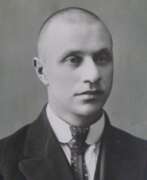

Vladimir Davydovych Burliuk (Russian: Владимир Давидович Бурлюк) was a Ukrainian avant-garde artist, known for his contributions as a Neo-Primitivist and Cubo-Futurist. Born on March 27, 1886, in the Russian Empire, Burliuk's work spanned various mediums, including painting and book illustration. His art is celebrated for its bold experimentation and pioneering spirit in the early 20th century avant-garde movement. Burliuk's life was tragically cut short when he died at the age of 32 during World War I in 1917.
Burliuk's artistic output is characterized by its innovative approach and his involvement in the avant-garde circles that radically transformed Russian art. His works were part of significant avant-garde exhibitions and movements, showcasing his commitment to pushing the boundaries of traditional art. Among his notable works are contributions to publications and exhibitions that captured the essence of the avant-garde, such as "Sadok Sudei (A Trap for Judges)" in 1910 and "Moloko kobylits (Milk of Mares)" in 1914. His art is recognized for its unique body of works, blending Cubism, Rayonism, and elements of Futurism, marked by stylistic unity and high valuation by connoisseurs.
Burliuk's legacy extends beyond his own creations; his involvement with key figures and movements of the time, including his brother David Burliuk, further emphasizes his role in shaping modern art. Despite his early death, Vladimir Burliuk's work remains a testament to the vibrancy and dynamism of the avant-garde movement, with his pieces held in high regard by collectors and experts alike.
For those interested in exploring the depths of avant-garde art, Burliuk's oeuvre offers a fascinating glimpse into the revolutionary spirit of early 20th-century artistic exploration. His contributions continue to inspire and intrigue art lovers, underscoring the lasting impact of his brief but impactful career.
Sign up for updates to stay informed about new product sales and auction events related to Vladimir Davydovych Burliuk, and immerse yourself in the world of avant-garde artistry that continues to resonate with collectors and art enthusiasts alike.
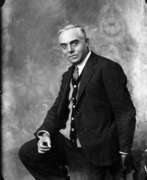

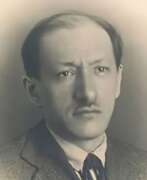

Giuseppe Cominetti was an Italian painter of the divisionist movement. He studied painting in Turin and also attended the Academy of Fine Arts in Milan.
His paintings by Giuseppe Cominetti are a mixture of symbolism and divisionism. He participated in the Promotrice of Genoa from 1903 to 1912. In 1909 he moved to Paris and exhibited at the Salon d'Autumn and signed Filippo Marinetti's Manifesto for Futurism. His painting was later influenced by Fauvism and Futurism.


Tullio Crali was an Italian futurist painter, self-taught and one of the founders of aerial painting.
Tullio Crali belonged to the national minority, Dalmatian Italians. He is considered one of the most important representatives of the second wave of futurism. He started painting in 1925, under the influence of Giacomo Balla, Umberto Boccioni and Enrico Prampolini.
He taught at the Italian School of Art in Cairo and developed his own separate current in futurism, the Sassentesi.
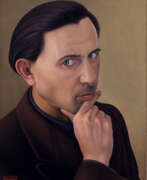

Cagnaccio di San Pietro, real name Natale Bentivoglio Scarpa, Italian painter of magical realism. He studied painting at the Academy of Fine Arts in Venice.
Cagnaccio di San Pietro in the beginning of his creative activity devoted to salon painting, was fond of futurism, then worked for a long time as a representative of the Italian variant of the New Realism. His work is characterised by portraits, nudes, still lifes, paintings of religious content and domestic subjects.
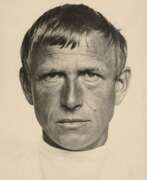

Wilhelm Heinrich Otto Dix was a German artist whose work stands as a stark, unyielding reflection of the societal tumult and trauma of the early 20th century. Born in 1891 in Untermhaus, Germany, Dix's early life was steeped in the arts, his ambition to become an artist nurtured by both familial influence and formal education in Dresden. His experiences as a soldier in World War I deeply influenced his artistic direction, leading him to vividly depict the horrors of war and the decay of the Weimar Republic with a brutal realism that became his signature style.
Dix's association with the Dada movement and the New Objectivity (Neue Sachlichkeit) further honed his critical, often cynical portrayal of post-war society. His works, such as "The Trench" and "War Cripples," expose the visceral aftermath of conflict, while his engagement with the Dadaists imbued his art with a disruptive, confrontational energy against societal norms and the art establishment.
Perhaps most notable is Dix's ability to capture the psychological depth and societal critiques through his portraits and landscapes, which ranged from the grotesque to the surreal. Paintings like "Portrait of the Journalist Sylvia von Harden" and the triptychs "Metropolis" and "War" are emblematic of his keen observation and stark depiction of the era's social and political unrest.
Despite facing significant adversity, including being labeled a degenerate artist by the Nazi regime and facing professional and personal setbacks, Dix's legacy as a painter and printmaker endures. His works are not only historical documents but also profound reflections on humanity, war, and society, resonating with collectors and art experts alike.
For enthusiasts of culture, art, and history, Dix's oeuvre offers an unflinching look into the human condition under the strain of societal and political upheaval. His contributions to painting and printmaking continue to be celebrated in museums and galleries worldwide, underscoring the enduring relevance of his work.
For those interested in exploring the profound depth and historical significance of Otto Dix's work, signing up for updates on new product sales and auction events related to his art can provide invaluable insights. This subscription is a gateway to staying informed about opportunities to engage with the tangible pieces of Dix's enduring legacy.


Gerardo Dottori was an Italian futurist painter who also belonged to the Novecento group.
Influenced by Giacomo Balla, Gerardo Dottori joined the futurist movement in 1911-1912. His works were part of the art competitions at the 1932 Summer Olympics and the 1936 Summer Olympics.
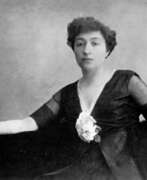

Aleksandra Aleksandrovna Ekster (Russian: Алекса́ндра Алекса́ндровна Эксте́р), a luminary of the Russian avant-garde, was a painter and designer whose work traversed the boundaries of Cubo-Futurism, Suprematism, and Constructivism, eventually influencing the Art Deco movement. Born in Białystok (then part of the Russian Empire, now Poland) and later splitting her life among Kiev, St. Petersburg, Moscow, Vienna, and Paris, Ekster played a pivotal role in bridging Russian and European artistic movements. Her innovative approach to art was characterized by dynamic movement, vibrant color contrasts, and geometric compositions, which were evident in her paintings, theater set and costume designs, and educational endeavors.
Ekster's studio became a hub for the intellectual and artistic elite, hosting figures like poets Anna Akhmatova and Osip Mandelstam, as well as painters Pablo Picasso and Georges Braque during her stays in Paris. Her involvement in significant art exhibitions, such as the Salon des Indépendants and the Salon de la Section d'Or in Paris, showcased her works alongside those of Jean Metzinger, Marcel Duchamp, and others, marking her as a key figure in the avant-garde community.
Beyond painting, Ekster's contributions to theater and design were profound. She worked on costume and set designs for Alexander Tairov's Chamber Theatre and participated in the revolutionary festivities' decoration in Kiev and Odessa. Ekster's pedagogical efforts included teaching at the Higher Artistic-Technical Workshop (VKhUTEMAS) in Moscow, fostering a new generation of avant-garde artists.
Ekster's work is housed in various international and private collections, reflecting her lasting impact on the art world. Her ability to integrate different genres and styles, along with her commitment to experimentation and innovation, made her one of the most influential women in the Russian avant-garde.
For those fascinated by the pioneering spirit of Aleksandra Aleksandrovna Ekster and the avant-garde movement, signing up for updates on new product sales and auction events related to her work is a compelling way to stay informed. This subscription ensures enthusiasts and collectors are always in the loop regarding opportunities to engage with Ekster's enduring legacy.
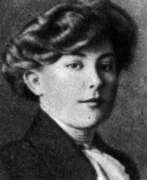

Vera Mikhailovna Ermolaeva (Russian: Ве́ра Миха́йловна Ермола́ева) was a Russian avant-garde artist, illustrator, and educator, renowned for her contributions to children's literature and modern art. Born in the village of Klyuchi, she emerged as a pivotal figure in the Russian avant-garde movement, known for her innovative approaches to book illustration and her role in shaping early 20th-century art education and theory.
Ermolaeva's career is marked by her significant involvement with the book-publishing studio "Today" (Segodnya) in Petrograd, where she, alongside other notable artists, produced hand-crafted picture books and lubki. Her illustrations for children's books, such as those written by Natan Vengrov and Alexander Vvedensky, reflect a unique blend of narrative and visual artistry, contributing to the development of a new genre of children's literature.
In addition to her illustration work, Ermolaeva's influence extended to art education. She played a crucial role at the Vitebsk Art School, inviting Kazimir Malevich to teach and eventually leading the institution. Her efforts alongside Malevich and others facilitated the formation of UNOVIS, a collective dedicated to exploring and promoting avant-garde art principles.
Ermolaeva's theoretical and practical work in the field of color theory at the State Institute of Artistic Culture (GINKHUK) further underscores her contributions to modern art. Her association with the "Association of Real Art" (Oberiu) and her involvement in creating avant-garde art circles highlight her commitment to exploring the intersections between art, theory, and society.
Her works, including "Still Life" and "The Concert. Composition on the Theme of Bernardino Licinio," are held in prestigious collections, such as the State Russian Museum, the State Tretyakov Gallery, the Pushkin Museum, the Museum of Modern Art (MoMA), and the Ludwig Museum, showcasing her enduring legacy in the art world.
For collectors and experts in art and antiques, Ermolaeva's story and creations offer a window into the vibrant world of the Russian avant-garde. Her dedication to art education, innovative approach to book illustration, and contributions to modern art theory make her a fascinating figure in the history of art.
To stay updated on new findings and auction events related to Vera Mikhailovna Ermolaeva's work, sign up for updates. This subscription will keep you informed about new product sales and auction events, allowing you to deepen your appreciation and understanding of this remarkable artist's legacy.
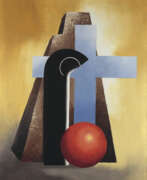

Fillìa is the name adopted by Luigi Colombo, an Italian artist associated with the second generation of Futurism. In addition to painting, his work included interior design, architecture, furniture and decorative objects.
Fillia became a representative of L' Aeropittura (Aeropainting), the dominant futurist style of the 1930s, in which the experience of flight was applied to depicting the landscape from the air; the world was no longer seen from a human perspective on the ground, but as if from an aircraft.
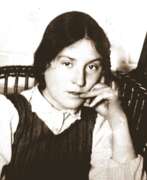

Nina Henrichovna Genke-Meller (Russian: Нина Генриховна Генке-Меллер) was a distinguished Ukrainian-Russian avant-garde artist, celebrated for her contributions as a Suprematist, Futurist, designer, graphic artist, and scenographer. Born on April 19, 1893, in Moscow, she emerged as a pivotal figure in the avant-garde movement, significantly influenced by the political and cultural upheavals of her time. Her multifaceted career took off after the October Revolution of 1917 when she actively participated in decorating the streets of Kyiv and Odesa for Revolution festivities alongside contemporaries like Aleksandra Ekster and Kliment Red'ko. Genke-Meller's artistic endeavors spanned various domains, including her role as a chief artist at the Golfstream futuristic publishing house, her pioneering work in graphic design, and her significant contributions to stage design, ceramics, and wallpaper manufacturing.
Her teaching stint at the All-Ukrainian State Center Studio from 1920 to 1924 marked a notable period in her career, where she influenced many through her artistic philosophies and practices. By 1924, Genke-Meller had moved to Moscow, further expanding her creative horizons as a stage designer and taking up roles in the decorative and applied arts. Her legacy includes a rich body of work that encapsulates the spirit of the avant-garde movement, with notable exhibitions showcasing her contributions to Ukrainian and Russian avant-garde art across various esteemed platforms like the National Art Museum of Ukraine, Villa Stuck in Munich, and The Ukrainian Museum in New York.
For collectors and experts in art and antiques, Nina Henrichovna Genke-Meller's works represent the revolutionary zeal of the avant-garde movement, offering a glimpse into the transformative power of art in the early 20th century. Her contributions continue to inspire and influence contemporary discussions on art and design, cementing her status as a key figure in the avant-garde narrative.
For those interested in exploring the profound impact and timeless appeal of Genke-Meller's art, signing up for updates related to her work offers an exclusive gateway to new product sales and auction events, providing collectors and enthusiasts with timely insights into the vibrant legacy of this avant-garde icon.
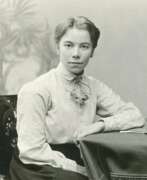

Elena Genrikhovna Guro (Russian: Еле́на Ге́нриховна Гуро́), born in 1877 in St. Petersburg, Russia, and passing in 1913, was a pioneering figure in the Russian Futurist movement. As a multifaceted artist, she delved into painting, writing, and poetry, marking her as a versatile and innovative force in the early 20th century Russian avant-garde. Guro's work is distinguished by its embrace of Futurism, a movement that sought to break away from traditional art forms and explore dynamic means of expression. Her contributions were not only limited to visual arts but also extended to literature, where she experimented with narrative forms and language, often incorporating nonsensical elements to challenge conventional aesthetics.
Guro's literary works, such as "The Little Camels of the Sky," demonstrate her experimental approach to language and form, embodying the Futurist fascination with the aesthetic possibilities of words. This approach is evident in her poetry and short stories, where she utilized single-word sentences and nonsense words to capture the essence of moments or convey a childlike perspective. Such techniques allowed her to explore the texture of language and its visual and auditory qualities, making her work resonate with the innovations of the Futurist and Dada movements.
Despite her early death at the age of 36, Guro's legacy continues to be celebrated for its contribution to the evolution of Russian modernism. Her work bridged the gap between the Symbolist movement and Futurism, contributing significantly to the dialogue around art and literature in her time. Her husband, Mikhail Matyushin, further propagated her artistic theories, ensuring that her innovative approach to color and form continued to influence Russian art and literature after her passing.
Elena Genrikhovna Guro remains an inspirational figure in the world of art and literature, embodying the spirit of innovation and exploration that defined the early 20th century avant-garde. Her works, which blend poetic language with vivid imagery, invite audiences to reconsider the boundaries between different art forms and the potential of language as an artistic medium.
For those intrigued by the rich tapestry of Russian Futurism and the unique voice of Elena Guro, signing up for updates on her works, sales, and auction events can deepen your appreciation and understanding of this pivotal artist's contributions. This subscription will ensure you stay informed about the latest insights and opportunities related to Elena Genrikhovna Guro's enduring legacy.
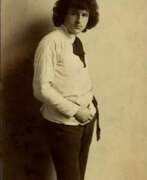

Nikolai Mikhailovich Gushchin (Russian: Николай Михайлович Гущин) was a Russian and Soviet artist, celebrated for his portraits, landscapes, and still lifes. His journey through art and life spanned continents and eras, marked by both acclaim and adversity. Gushchin's formative years were enriched by academic training, leading to early works that showcased his talent through pencil drawings like "Portrait of mother" and "portrait of a nephew of Victor". His evolution as an artist is noted for a transition from Impressionism to incorporating elements of Cubism and Futurism, demonstrating a vibrant exploration of modern art movements.
Gushchin's career took a pivotal turn during his years in exile from 1919 to 1947, a period that saw him achieve recognition across Europe. He became a member of the expert council of the Louvre, and his works were acquired by museums in Paris, Grenoble, Monte Carlo, and Nice. His style during these years melded Art Nouveau, Symbolism, Expressionism, and Fauvism into a distinctive mode of expression. Despite his success abroad, Gushchin's return to the Soviet Union in 1947 brought challenges, including the ideological ostracism that limited his opportunities to teach and exhibit his work.
Gushchin's legacy includes a significant body of work that remains influential. His paintings and drawings, characterized by expressive color and dynamic compositions, are held in high regard both in Russia and internationally. The Radishchev Museum boasts the largest collection of his works, illustrating the breadth of his talent and the diversity of his subjects.
For collectors and experts in art and antiques, Gushchin's oeuvre offers a fascinating glimpse into the intersection of individual creativity and historical tumult. His works not only embody the stylistic shifts of the 20th century but also reflect the personal resilience and artistic integrity of their creator.
To stay informed about sales and auction events featuring Nikolai Mikhailovich Gushchin's work, sign up for updates. This subscription will ensure you're the first to know about opportunities to acquire pieces by this remarkable artist.


Ivan Vasilievich Kliun (Russian: Иван Васильевич Клюн) was a seminal figure in the Russian Avant-Garde movement, a painter, sculptor, and art theorist associated with Suprematism, a movement that sought to break down art into its basic geometric components. Born in Bolshiye Gorki, Kliun was deeply involved with the avant-garde circles that revolutionized Russian art in the early 20th century. His journey into the art world took him through studies in Kiev, Warsaw, and Moscow, culminating in a long-standing collaboration and friendship with Kazimir Malevich.
Kliun's artistic contributions were vast, ranging from his exploration of color theories to his pioneering Suprematist works that featured geometric shapes against stark backgrounds. Despite the changing tides of political and artistic favor in Soviet Russia, Kliun remained committed to his abstract and purist visions, even when abstraction fell out of favor with the Soviet authorities in the late 1920s.
His works, characterized by a unique integration of light and color to enhance the depth and intensity of the abstract forms, are significant for their experimental approach to Suprematism. Unlike many of his contemporaries who shifted towards Socialist Realism under state pressure, Kliun continued his abstract explorations discreetly. Today, his works are recognized for their innovation and contribution to the avant-garde movement, with pieces displayed in prestigious collections like the Costakis collection and international exhibitions.
For enthusiasts and collectors interested in the avant-garde movement and Kliun's groundbreaking work, staying updated on exhibitions and sales of his art is essential. Sign up for updates to stay informed about new product sales and auction events related to Ivan Vasilievich Kliun and explore the depths of Russian Avant-Garde art.
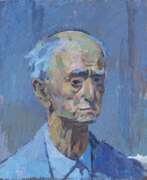

Bernhard Kretzschmar was a German painter and graphic artist.
Kretzschmar studied at the Dresden Academy, in 1920 destroyed most of his work and began his career anew. In 1932 he co-founded the Dresden Secession, but later the Social Democrats banned him as a degenerate artist, and his paintings were removed from museums and galleries. Kretzschmar hated the Nazis and had to flee the country.
Like many artists of his generation, he dabbled in Expressionism, then switched to Verismo. He skillfully tried his hand at both Futurism and Impressionism. He painted on the themes of social poverty, as well as comically depicting the bourgeois way of life. In 1945, most of his works were destroyed in an air raid.
After World War II, social motifs receded into the background and Kretzschmar focused more on landscapes, more often in the suburban areas of Dresden. He also painted several self-portraits with somber, skeptical and ironic facial expressions during his lifetime, which provide a vivid characterization of the artist.
From 1946, Bernhard Kretzschmar worked as a professor at the University of Fine Arts in Dresden. In 1959 he received the National Prize of the GDR, and since 1969 he has been a corresponding member of the German Academy of Arts in East Berlin.
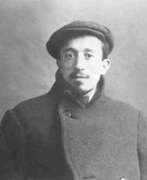

Mikhail Vasilyevich Le Dentu (Russian: Михаил Васильевич Ле-Дантю), also known as Mikhail Le-dantyu or Le Dante, was a Russian artist whose life and career were tragically cut short. Born into the culturally rich and historically significant Le Dante family, Mikhail's lineage was intertwined with both French and Russian heritage, evident in the dramatic tales of his ancestors, such as Camille Le Dante who followed her Decembrist husband to Siberia. Despite his noble ancestry, Mikhail's father lived the modest life of a Russian intellectual-commoner, which influenced Mikhail's upbringing and values.
Le Dentu's artistic journey began early, with a passion for drawing manifesting in his childhood. His talent led him to study at the Academy of Fine Arts, where he quickly aligned with the avant-garde movements of his time. His involvement with the "Union of Youth" and participation in groundbreaking exhibitions like "Donkey's Tail" showcased his commitment to exploring new artistic directions, diverging from traditional academia to embrace folk art and the burgeoning Russian avant-garde.
Mikhail's exploration of art was not limited to Russia; his travels to Georgia introduced him to the works of self-taught artists, expanding his understanding and appreciation of art beyond the conventional. His work, although largely lost, remains a vital piece of Russian art history, offering insights into the avant-garde movements of the early 20th century and the cultural exchanges between Russia and France. His life, marked by innovation and tragedy, reflects the turbulent times he lived in, making his contribution to art all the more poignant.
Le Dentu's legacy, despite the small number of surviving works, is significant for understanding the evolution of Russian art and its interactions with European movements. His story is a reminder of the myriad of influences that shape an artist's work and the often-unpredictable path of creative expression.
If you're interested in the fascinating intersections of art, history, and culture, and how they manifest in the works of artists like Mikhail Vasilyevich Le Dentu, sign up for updates. Stay informed about new discoveries, sales, and auction events related to his work and legacy.
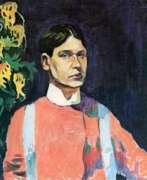

Aristarkh Vasilyevich Lentulov (Russian: Аристарх Васильевич Лентулов) was a prominent figure in Russian avant-garde art, celebrated for his distinctive use of color and innovative approach to Cubism. Born in Nizhneye Lomovo, Penza oblast, Russia, in 1882, Lentulov's early years were spent in a religious family, setting a foundation that would influence his rich and vibrant artistic style. His education at the art institutes in Penza and Kiev, followed by his studies under Dmitry Kardovsky in St. Petersburg, prepared Lentulov for a groundbreaking artistic career.
Lentulov's artistic journey took a significant turn when he moved to Paris in the winter of 1911. There, he was exposed to the works of leading French Cubists at the Académie de la Palette, including Henri Le Fauconnier. This period marked Lentulov's deep dive into Cubism and Orphism, influenced by his interactions with avant-garde artists such as Jean Metzinger, Albert Gleizes, and Fernand Léger. Upon his return to Russia, he became one of the founders of the Jack of Diamonds, a group that exhibited artists with "leftist tendencies" and embraced foreign, mostly French Cubists.
Lentulov's style uniquely combined the spatial concepts of Cubism with the vibrant colors of Fauvism, drawing on Russian folk art to create compositions that were both innovative and deeply rooted in Russian culture. His works, characterized by their luminous color and dynamic composition, played a significant role in the development of Russian Futurism and Cubo-Futurism. Notably, his involvement in theatrical projects, including set designs for the Kamerny Theatre and the Bolshoi Theatre, highlighted his versatility and creative genius.
Aristarkh Lentulov's legacy is preserved in his contributions to the avant-garde movement, and his works continue to be celebrated for their bold experimentation and vibrant expression. His paintings, such as "Saint Basil's Cathedral" and "The Belfry of Ivan the Great," are held in high esteem, showcasing his ability to capture the essence of Russian architecture and culture through a modernist lens.
Art enthusiasts and collectors recognize Lentulov as a pivotal figure in the evolution of modern Russian art. His innovative techniques and bold use of color have cemented his place in art history as a master of Russian avant-garde.
For updates on exhibitions and auction events featuring Aristarkh Vasilyevich Lentulov's work, sign up for our newsletter. Stay informed about the latest sales and opportunities to add a piece of Russian avant-garde history to your collection.
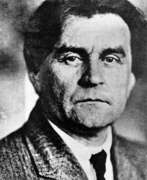

Kazimir Severinovich Malevich (Russian: Казимир Северинович Малевич) was a pioneering Russian artist, known for his profound influence on the development of abstract art in the 20th century. His nationality and specializations in painting, art theory, and teaching have cemented his place as a pivotal figure in the avant-garde movement, particularly for his role in founding the Suprematism movement. This movement, characterized by its focus on basic geometric shapes and a limited color palette, aimed to convey the supremacy of pure artistic feeling over the depiction of objects.
Malevich's art and theories have had a lasting impact on the course of modern art, challenging traditional perceptions of form and composition. His most famous work, "Black Square," epitomizes the essence of Suprematism. It represents a radical break from past art forms and a move towards abstraction, where the emotional and spiritual dimensions of art are prioritized. This piece, along with others like "White on White," has been exhibited in prestigious museums and galleries worldwide, showcasing Malevich's enduring legacy.
For collectors and experts in art and antiques, Malevich's works are not just paintings but are significant historical artifacts that embody a transformative period in art history. His contributions extend beyond his canvases, influencing sculpture, culture, and the broader artist school. His innovative approach to art has paved the way for future generations of artists, making his works highly sought after in the art and antique collecting community.
For those interested in the avant-garde movement and the evolution of abstract art, staying informed about Kazimir Malevich's contributions is essential. We invite you to sign up for updates related to Malevich, including notifications on new product sales and auction events. This subscription will keep you at the forefront of the latest discoveries and opportunities to acquire pieces connected to this revolutionary artist.


Hedwig Marquardt, full name Hedwig Frieda Käthe Marquardt, was a German expressionist painter and ceramicist.
She studied art at the Magdeburg Art School and then at the academy in Munich, and worked at the majolica manufactory in Karlsruhe, Kieler Kunst Keramik. At the beginning of her artistic career, Hedwig Marquardt preferred pure abstraction, but later achieved a fusion of abstraction and naturalism. Her work also combines cubist and futuristic, art deco and expressionist techniques.
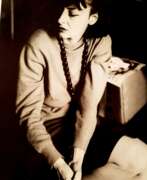

Titina Maselli is an Italian pop-art artist and stage designer.
Born into a creative family, she has lived and worked in Rome, Paris and New York.
Maselli's works futuristically depict the modern dynamic life of big cities with their skyscrapers, nighttime traffic lights and neon signs. In Titina Maselli's cities athletes compete, cyclists race, boxers fight furiously - the artist was able to portray all this best in pop-art style.
Titina Maselli has also worked as a stage designer, creating sets and costumes for famous theatrical productions.
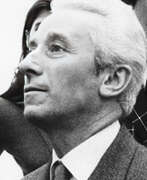

Bruno Munari was an Italian painter, sculptor, graphic artist, designer, theorist, and educator.
He was called the orchestra man: Munari drew, illustrated, sculpted, photographed, designed advertisements, furniture and toys, wrote books, taught, made movies. Pablo Picasso called him the "new Leonardo."
As an inventor, Munari laid the foundations for many new kinds of visual art. For example, it was he who invented the suspended structures-mobiles that respond to the slightest fluctuations in the air, "useless machines" that are designed to distract the viewer from the everyday hustle and bustle.


Wangechi Mutu is a Kenyan-born American visual artist, known primarily for her painting, sculpture, film, and performance work.
Born in Kenya, she has lived and established her career in New York City for more than twenty years. Mutu's work has directed the female body as subject through collage painting, immersive installation, and live and video performance all the while exploring questions of self-image, gender constructs, cultural trauma, and environmental destruction, as well as notions of beauty and power.
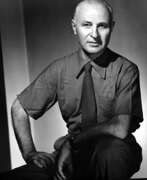

Emilio Pettoruti was an Argentine painter, heralded as a pioneer of abstract art in South America. Born in La Plata, Argentina, in 1892, Pettoruti was self-taught, drawing inspiration from his surroundings and experiences from an early age. His artistic journey took him to Italy in 1913 on a government scholarship, where he immersed himself in the avant-garde movements of Europe, notably Futurism, and interacted with key figures of the time such as Pablo Picasso and Juan Gris. This European sojourn significantly influenced his artistic direction, introducing him to synthetic cubism, futurism, and the early Renaissance painting, which he would later blend into his unique style.
Pettoruti's work, especially post his return to Buenos Aires, scandalized and fascinated the Argentine public in equal measure. His avant-garde cubist exhibition in 1924 marked a pivotal moment in Argentine art, challenging traditional concepts and inviting viewers into a dialogue with the new and modern. He frequently depicted musicians and harlequins, using these figures to explore themes of anonymity, cultural identity, and the essence of human expression. Through his abstract compositions, Pettoruti conveyed a sense of rhythm and movement, often incorporating elements of light as a tangible presence within his works. Notably, his Copa series and later abstract works exemplify his mastery of form, color, and light, showcasing a progression towards complete abstraction.
Among Pettoruti's significant works are "El Sifón" (1915), "La Grotta Azzurra di Capri" (1918), and "Quinteto" (1927), with many held in prestigious collections, including the Museo Nacional de Bellas Artes in Buenos Aires. His artistic legacy is a testament to his role as a critical figure in introducing and establishing avant-garde art in Latin America.
For those intrigued by Emilio Pettoruti's groundbreaking work and wish to explore more about his contributions to modern art, signing up for updates can provide exclusive insights into upcoming sales and auction events dedicated to his art. This subscription offers a unique opportunity for collectors and experts in art and antiques to stay informed about the vibrant legacy of Pettoruti's work.
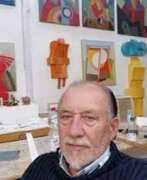

Victor Popov is a constructivist artist originally from Kazakhstan (USSR) who has been living and working in Düsseldorf, Germany since 1991. He studied at the School of Applied Arts in Lviv, Ukraine. In the mid-1980s he was a member of the artist group "Ostrov" in St. Petersburg, Russia, and has been working as a freelance artist since then, holding numerous exhibitions.
Victor Popov's work is built on Suprematism and Constructivism, with additional influences from Cubism and Futurism. His paintings are at once bright and aligned, free and structured, and there is always something painterly in Popov's sculptures.
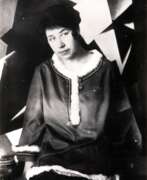

Lyubov Sergeyevna Popova (Russian: Любовь Сергеевна Попова) was a distinguished Russian avant-garde artist, celebrated for her pivotal role in the development of Cubism, Suprematism, and Constructivism during the early 20th century. Her innovative approach to art combined dynamic abstraction with geometric precision, reflecting the revolutionary spirit of her time. Popova's work transcends mere visual appeal, embodying the synthesis of artistic experimentation and the utopian ideals of her era.
Popova's artistic journey was marked by her relentless exploration of various mediums, including painting, textile design, and theater set design. Her contributions to art were not confined to her canvases; she actively participated in designing costumes and sets for theatrical productions, thereby influencing the visual language of Russian Constructivism. Her notable works, such as "The Traveler" and her series of "Painterly Architectonics," are celebrated for their bold use of color and form. These pieces, often showcased in prestigious galleries and museums worldwide, highlight her mastery of abstract composition and her ability to convey movement and depth through geometric shapes.
Popova's legacy extends beyond her artistic achievements. She was a key figure in the Artist School movement, where she dedicated herself to education and the dissemination of avant-garde principles. Her commitment to cultural innovation made her a central figure in discussions on the role of art in society, particularly in the context of the Russian Revolution. Today, collectors and experts in art and antiques revere Popova's work for its historical significance and its contribution to the evolution of modern art.
For enthusiasts and connoisseurs seeking to delve deeper into the world of avant-garde art, Lyubov Sergeyevna Popova's work remains a beacon of innovation and creativity. We invite you to sign up for updates on new product sales and auction events related to Popova's art. This subscription is an opportunity to stay informed about the latest discoveries and offerings in the realm of this groundbreaking artist.
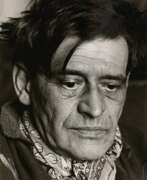

Jean Pougny, birth name — Ivan Albertovich Pougny (Russian: Иван Альбертович Пу́ни), was a Russian-French artist who changed his artistic manner several times during his artistic development from avant-gardism, cubism, futurism and suprematism to lyrical primitivism in the vein of a movement in which Pierre Bonnard and Édouard Vuillard also worked.
After World War I, Pouny emigrated via Finland to Germany and then to France, where he worked as a set designer for the Russian Ballet and collaborated with artists such as Le Corbusier.
Between 1921 and 1956, Puni had 12 solo exhibitions in Berlin, Paris, New York and London, and participated in over a hundred group exhibitions. In 1952, he was made a Knight of the Legion of Honour.
Jean Pugni's works are currently in the collections of major museums around the world.
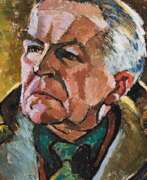

Cyril Edward Power was an English artist best known for his linocut prints, long-standing artistic partnership with artist Sybil Andrews and for co-founding the Grosvenor School of Modern Art in London in 1925. He was also a successful architect and teacher.


Enrico Prampolini was an Italian futurist painter and sculptor.
Enrico Prampolini published his manifesto Scenografia e coreografia futurista (Futuristic scenography and choreography) in 1915; in the same year he began working as a theatre artist and theatre costume designer.
In 1925 Enrico Prampolini was awarded an honorary diploma at the World Exhibition in Paris, the second most important award in the class of theatrical art.
When Mussolini came to power in Italy, Enrico Prampolini, like many other futurist artists, supported the new regime. In 1932 he, together with Gerardo Dottori and Mario Sironi, leads and implements in a futuristic style the decoration of the grandiose "Exhibition of the Fascist Revolution" (Mostra della Rivoluzione Fascista) in Rome.


Ivan Albertovich Puni (Russian: Иван Альбертович Пуни) was a pivotal figure in the early 20th-century art world, merging his Russian roots with avant-garde European influences. Born into a culturally rich family, his exposure to art and music from a young age set the stage for his diverse artistic explorations. Puni is celebrated for his innovative contributions to the Russian avant-garde, notably through his involvement in Cubism, Futurism, and Suprematism. His work played a significant role in shaping the prewar development of these movements.
Puni's artistic journey was marked by a constant evolution of style, as evidenced by his Berlin period from 1920 to 1924, a time of intense creativity and experimentation. During these years, Puni delved into Dadaism, reconstructing works with a new artistic vision that reflected his critical engagement with non-objective art. This period was crucial in the synthesis of Russian avant-garde styles with Western art practices, leading him to articulate his concept of Constructive Naturalism.
His exhibitions spanned continents and decades, from early showcases in St. Petersburg and Paris to retrospectives in New York and London. These exhibitions not only highlighted his versatile style but also established his place in the international art scene. Puni's work, including notable exhibitions at Galerie Louis Carré and Musée National d'Art Moderne, remains influential, underscoring his legacy as an artist who bridged cultural and artistic divides.
For collectors and art enthusiasts intrigued by Ivan Albertovich Puni's groundbreaking work, staying informed about upcoming sales and auction events is essential. To ensure you don't miss out on the opportunity to own a piece of this avant-garde artist's legacy, sign up for updates specifically tailored to new product sales and auction events related to Ivan Albertovich Puni. This subscription will be your gateway to exploring the profound impact and timeless appeal of Puni's art in the modern world.
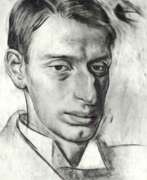

Nikolai Radlov (Russian: Николай Эрнестович Радлов) was a multifaceted Russian artist, born in St. Petersburg in 1889 and passing away in 1942, whose work spanned a wide range of artistic endeavors including graphic art, painting, theatrical design, illustration, caricature, teaching, and art criticism. A student of D.N. Kardovsky, Radlov was known for his involvement with the "World of Art" group, and his teaching career was significant, influencing many with his innovative approaches to art and design .
Radlov's creativity was evident in his diverse contributions to art, characterized by his work in satirical magazines and book illustrations, as well as his theoretical writings on art and graphics. His pre-revolutionary contributions were notable for his art criticism published in prestigious magazines, setting the stage for his later works that explored a range of aesthetic preferences from classicism to futurism, indicating a versatile and evolving artistic philosophy .
His works, such as the multicolored brush-stencil on paper "TASS 60, The Miracle of Fascist Photography," created in 1941, are celebrated for their innovative use of medium and technique. This particular piece is part of the collection at the Museum of Modern Art (MoMA), showcasing Radlov's significant impact on the fields of graphic design and illustration.
For collectors and experts in art and antiques, Radlov's legacy offers a rich tapestry of Russian art history, encapsulating the tumultuous transitions from pre-revolutionary aesthetics to the avant-garde movements that followed. His contributions to graphic art and illustration, along with his theoretical writings, provide insightful perspectives into the evolution of Russian visual culture in the early 20th century.
Sign up for updates on Nikolai Radlov to stay informed about new product sales and auction events related to this remarkable artist.
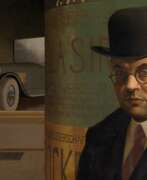

Georg Scholz is a German painter and a vivid representative of the New Objectivity movement.
Scholz studied painting at the Karlsruhe Academy of Fine Arts and continued his studies in Berlin with Lovis Korint. After serving in the army in World War I from 1915 to 1918, he returned to painting in the style of Cubism and Futurism. Scholz's entry into the German Communist Party is reflected in his paintings, which sharply and sarcastically criticize the social and economic order of post-war Germany.
Georg Scholz very soon became one of the leaders of the New Realism, a group of artists who practiced the most cynical form of realism. In 1925 he received a professorship at the State Academy of Art in Karlsruhe. In 1926 he began collaborating with the satirical magazine Simplicissimus, and in 1928 he visited Paris.
After Hitler and the National Socialists came to power in Germany in 1933, Scholz immediately lost his teaching job. His work was declared degenerate art, his works were withdrawn from collections in 1937, and the artist himself was banned from painting in 1939.
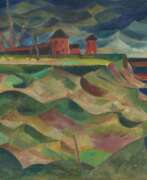

Paul Adolf Seehaus, also known as Barnett, was a German expressionist painter.
Under the guidance of expressionist August Mack (1887-1914) Seehaus mastered the styles of Fauvism, Cubism and Futurism. At the "Rhenish Expressionist Exhibition" in 1913, Seehaus earned the respect of critics as an independent expressionist painter. The talented young artist was expected to produce exciting new works, but sadly he died of pneumonia at the age of 27.
Paul Seehaus painted urban industrial landscapes, futuristic and rural views, and paintings on religious themes. His colors changed from a bright palette to a dark palette during the tragedy of World War I, but then he returned to optimistic watercolors.
As part of the Nazi "Degenerate Art" campaign of 1937, the Nazis withdrew some of Seehaus's expressive paintings from collections.
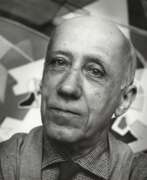

Gino Severini was an Italian painter and a prominent figure in the Futurist movement, known for his dynamic interpretation of movement and light in his artworks. Born in Cortona, Italy, in 1883, Severini moved to Paris in 1906, where he became deeply involved in the avant-garde scene, mingling with leading artists and embracing the vibrant cultural milieu of the city. His work often depicted lively urban scenes, dancers, and the energetic pace of modern life, distinguishing him within the Futurist movement for his unique focus on human figures and lively settings rather than the mechanical world.
Gino Severini's style evolved significantly over the years, moving from Futurism to incorporating elements of Cubism and later adopting a more classical approach in his art. After World War I, he aligned with the "return to order" movement, focusing on classical harmony and balance, which is evident in works like "The Two Pulchinellas." His later years saw him exploring various media, including mosaics and frescoes, contributing significantly to modern mosaic art and earning him the title "Father of Modern Mosaic."
Gino Severini's works are showcased in prestigious galleries worldwide, including the Museum of Modern Art (MoMA) in New York, where his influence on 20th-century art is celebrated. His contributions to art theory, his exploration across different art forms, and his ability to capture the essence of his time make Severini a fascinating subject for art collectors and experts alike.
For those interested in the evolution of modern art and the interplay between different artistic movements, Severini's work offers a compelling study of creativity and innovation. If you are intrigued by Gino Severini's contributions to the art world and wish to stay informed about upcoming sales and auction events related to his works, consider signing up for updates to deepen your knowledge and appreciation of this pivotal artist.
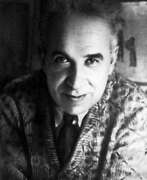

David Petrovich Shterenberg (Russian: Давид Петрович Штеренберг) was a Ukrainian-born Russian artist, recognized for his significant contributions to painting and graphic art. Born into a Jewish family in Zhitomir, Ukraine, Shterenberg's journey in art began in Odessa, leading him to Paris between 1906 and 1912, where he immersed himself in the vibrant artistic community. His studies at the Académie Vitti and interactions with notable artists like Kees van Dongen shaped his early artistic endeavors. Shterenberg's work, influenced by Paul Cézanne and Cubism, is celebrated for its expressive imagery, clear composition, and the strategic use of space.
Shterenberg's art evolved significantly over time, reflecting his deep engagement with the cultural shifts of his era. After returning to Russia post-1917 Revolution, he became an influential figure in Soviet art, leading the Department of Fine Arts at the People's Commissariat for Education and founding the Institute of Artistic Culture. Despite facing challenges under Soviet authority, which pushed him towards a more 'realistic' style, Shterenberg remained true to his unique artistic vision. His later years saw a return to themes of lyrical contemplation, notably in his Biblical Subjects series, completed before his death in 1948.
Today, Shterenberg's legacy lives on in major public galleries in Russia, including the Tretyakov Gallery, the Pushkin Museum, and the Russian Museum, as well as in private collections worldwide. His work encompasses a broad spectrum, from avant-garde experiments to intimate expressionist pieces, securing his place in the annals of modern art.
For enthusiasts and collectors alike, David Petrovich Shterenberg's oeuvre offers a rich exploration of early 20th-century art, marked by its innovative use of form and color, and its reflective engagement with the artist's cultural heritage and contemporary political landscape. Sign up for updates on new product sales and auction events related to Shterenberg, and discover more about this pivotal artist's contributions to the world of art.




Nikolai Mikhailovich Suetin (Russian: Николай Михайлович Суетин), a pivotal figure in Russian Suprematism, was celebrated for his innovative contributions to art, design, and ceramics. Born in 1897, Suetin's journey into the realms of avant-garde art began under the mentorship of Kazimir Malevich at the Vitebsk Higher Institute of Art. His dedication to Suprematism, an art movement emphasizing geometric forms and pure artistic feeling over representational elements, marked him as one of Malevich's most distinguished disciples.
Suetin's artistry was not confined to painting; he significantly impacted the design of ceramics and porcelain at the State Lomonosov Ceramics Factory, where he applied avant-garde principles to everyday objects, making Suprematism accessible beyond the canvas. His designs for the USSR pavilions at World Exhibitions in Paris (1937) and New York City (1939) showcased his versatility and ability to merge art with architectural spaces, illustrating his belief in the integration of art into daily life.
Notable works by Suetin include "Suprematist Composition with Black Rectangle," "Woman with a White Saw," and the "Scarecrow," along with innovative porcelain designs such as the "Suprematic Inkwell" and the "Tractor" service, embodying the essence of Suprematism through functional objects.
His legacy extends beyond his creations to his influence on the development of Russian modernist aesthetics and his efforts to infuse Suprematism into the fabric of Soviet culture. Suetin's work remains celebrated for its pioneering approach to abstract art and design, holding a permanent place in the annals of 20th-century art history.
For collectors and experts in art and antiques, Nikolai Mikhailovich Suetin represents a unique intersection of revolutionary artistic theory and practical application. His contributions continue to inspire and resonate, emphasizing the power of abstract forms and the potential of art to transcend conventional boundaries.
To stay informed about new product sales, auction events, and updates related to Nikolai Mikhailovich Suetin's work, signing up for updates offers an exclusive insight into the legacy and continued influence of this iconic artist.
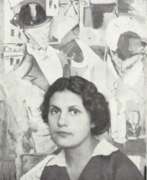

Nadezhda Andreevna Udaltsova (Russian: Наде́жда Андре́евна Удальцо́ва) was a Russian avant-garde artist known for her contributions to Cubism and Suprematism and her participation in the avant-garde movement of pre-revolutionary Russia. Udaltsova was born into an officer's family in Orel, western Russia, on December 29, 1886, and died on January 25, 1961, in Moscow, USSR. Udaltsova was deeply influenced by French Cubism, which she encountered in the art collection of Sergei Shchukin. This encounter was a decisive turning point in her artistic path, leading her to post-impressionism and then to avant-garde art forms.
After the 1917 revolution, her art was recognized by the new regime. Udaltsova played a significant role in education, as a professor and senior lecturer at VKhUTEMAS, the Higher Art and Technical Workshops, and a member of the Institute of Artistic Culture (Inhuk). Despite hardships, including the NKVD's execution of her husband Alexander Drevin in 1938, and becoming persona non grata in Soviet art circles, she continued her artistic endeavors, holding a solo exhibition in 1945 and participating in a group exhibition in 1958.
Udaltsova's legacy is remarkable not only for her artistic achievements, but also for the challenges she overcame. Her work is in prestigious collections, including the Museum of Modern Art (MoMA), attesting to her indelible impact on the art world.
For those interested in learning more about Nadezhda Andreevna Udaltsova's work and life, it will be helpful to visit the museums that house her works or subscribe to our newsletters about exhibitions and auctions featuring her art. This will allow a deeper understanding of this remarkable artist's contribution to the avant-garde movement and the art world in general.
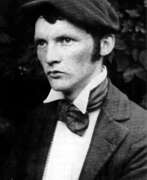

Heinrich Vogeler was a German artist and philosopher, a representative of the German Art Nouveau. A versatile and talented artist, he painted, watercolored, composed poems, designed, designed and decorated. Over time, his style of art changed over a wide range.
During World War I, from 1914 to 1917, Vogeler was on the Eastern Front as a volunteer and made sketches, which resulted in his pacifist sentiments.
In the mid-1920s he visited the Soviet Union several times and his impressions resulted in paintings in his own "complex style: "Karelia and Murmansk" (1926), "Building a New Life in the Soviet Republics of Central Asia" (1927), and "Baku" (1927). In 1931 Vogeler received an invitation to work in the USSR. The coming to power of the Nazis in Germany made it impossible for him to return home, and after Hitler's invasion Vogeler among many was deported to the Kazakh SSR, where he died.
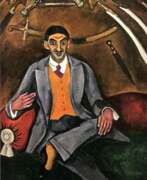

Georgy Bogdanovich Yakulov (Russian: Гео́ргий Богда́нович Яку́лов) was a multifaceted Armenian artist renowned for his contributions across several artistic domains, including painting, graphic art, stage design, and art theory. Born on January 16, 1884, in Tiflis (now Tbilisi), Yakulov's work is celebrated for its abstract art and avant-garde approach, blending Eastern influences with European modernism. His art is notable for its abstract qualities, rich decorative colors, and a unique blend of romantic expressionism with a fascination for Oriental exoticism.
Yakulov's journey into the art world was marked by significant milestones, such as his studies at the Moscow School of Painting, Sculpture and Architecture, and his military service in northeast China, which introduced him to Eastern light effects and decoration. His artistic career flourished with exhibitions across Moscow, Paris, and Berlin, where he became associated with notable movements and figures, including the Delaunays and their theory of Simultanism.
A pivotal moment in Yakulov's career was his contribution to theatre, most notably his work with the Moscow Chamber Theatre and his designs for ballets, including those commissioned by Diaghilev for the Ballets Russes. This period highlighted his ability to merge traditional theatrical techniques with modernist abstraction, creating a lasting impact on stage design.
His theories, particularly the "Theory of Colored Suns," showcased his innovative approach to art, emphasizing the importance of light and color, which he explored through his essays and designs. Despite his passing on December 28, 1928, Yakulov's legacy endures through his contributions to modern art and theatre, with works displayed in notable galleries and a special place among avant-garde artists.
For art collectors and enthusiasts interested in exploring the rich tapestry of Eastern and European avant-garde movements, Georgy Bogdanovich Yakulov's work represents a fascinating convergence of cultures and artistic philosophies. To stay updated on new discoveries and exhibitions related to Yakulov, consider signing up for updates. This will ensure you're always informed about sales and auction events celebrating his remarkable legacy.
